人教新目标九年级英语第十四单元优秀教学设计
人教版新目标九年级英语unit14教案(含习题)

Unit 14 Have you packed yet?学习目标:1.综合复习各种基本时态,包括现在完成时态、一般现在时、一般过去时、一般将来时等;按类别复习词汇。
2.谈论近来发生的事件及对未来的计划。
3.增强学生做事的条理性及计划性。
一、词汇(一)基础词汇bathing 游泳,洗澡suit衣服,服装towel毛巾,手巾water浇灌,浇水guidebook 旅游手册,指南refrigerator 冰箱garage 汽车库,汽车间suitcase 小提箱,衣箱chop 砍,劈wood木头,木材light点燃,点着village乡村,村庄well 井,水井farm农场,农庄member 成员,会员,一份子scene (戏剧、歌剧等)的发生地点,背景last最近的,最后的major 较大的,较大的范围的hit成功而轰动一时的事物(如歌曲等) appear出现,露面,(公开)演出miss错过,遗漏lead 领导,主角mostly主要的,大部分air(音乐)曲调,旋律,乐曲poem诗,韵文(二)重点短语1. some day来日,有一天2. be off离开,走开3. bathing suit游泳衣4. water the plants浇花儿5. lock the windows锁窗子6. pack the camera把照相机装包里7. put in放进,进入8. turn off关闭9. clean out something清除某物内部使之整洁10. clean up something整洁,清理某物11. take the dog for a walk遛狗12. chop wood砍柴13. love doing something喜爱做某事14. light the fire for breakfast点火做早饭15. collect water 挑水16. write original songs写原创歌曲17. make a music video制作音乐录影带18. a hit CD一张流行的CD19. go on a world tour进行世界巡20. in search of寻找,寻求21. hope to do something 希望做某事22. so far迄今为止23. be sure (not) to do一定(不)要做某事24. spend time (in) doing花费时间做…25. think of 想到,考虑26. turning point转折点27. in one‟s life在某人的一生28. be off to离开去(某地)29. air show音乐表演二、日常用语1.Have you watered the plants? No,I haven’t.你已经浇花了吗?不,我没有。
人教版英语九年级全册Unit14SectionB1(1a1e)教学设计

(一)教学重难点
1.重点:
(1)掌握本节课的核心词汇和短语,如:destiny, talent, devoted, ambition等。
(2)运用一般过去时、一般现在时和一般将来时描述名人的生平事迹。
(3)提高学生的听力、口语、阅读和写作能力。
2.难点:
(1)正确运用一般过去时、一般现在时和一般将来时,避免混淆。
2.每组选取一位代表进行汇报,分享讨论成果。
(四)课堂练习
1.教师设计以下练习,巩固所学知识:
(1)填空题:结合课文内容,用一般过去时、一般现在时和一般将来时填空。
(2)选择题:根据听力材料,选择正确的答案。
(3)写作题:仿照课文,写一篇关于自己偶像的文章。
2.学生独立完成练习,教师给予反馈和指导。
二、学情分析
针对人教版英语九年级全册Unit14SectionB1(1a1e)的教学内容,对学生学情进行分析如下:
1.学生在九年级阶段已经具备了一定的英语基础,能够运用简单的英语进行交流,但在词汇、语法、听力等方面仍有待提高。
2.学生对于名人的了解大多停留在表面,对于名人的生平事迹、成就及其影响了解不足,需要通过本节课的学习,拓宽知识面,提高文化素养。
3.学生在英语学习过程中,自主学习能力较弱,需要教师在教学中加以引导,培养学生的学习兴趣和自主学习能力。
4.学生在合作学习方面有一定的基础,但部分学生在小组讨论中表现不够积极,需要教师激发学生的参与热情,提高合作学习效果。
5.学生在情感态度方面,正处于青春期,对生活充满好奇,但部分学生对自己的未来缺乏明确目标,需要通过本节课的学习,激发学生的理想与信念,培养其积极向上的人生态度。
(二)过程与方法
人教版九年级英语全册Unit14SectionA(1a2d)教学设计
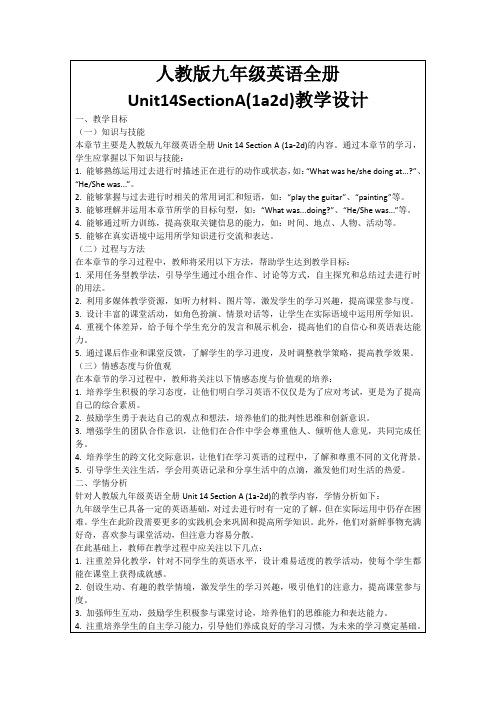
a.完成课本练习册中与本节课相关的练习题,包括填空、选择、改错等,以加强学生对过去进行时知识的掌握。
b.根据课堂所学,编写一段对话,至少包含5个过去进行时的句子,要求内容生动、有趣,能够体现过去进行时在实际语境中的应用。
c.挑选一篇短文,将其中的现在进行时句子改为过去进行时,以加深学生对两种时态区别的理解。
4.差异化教学:
a.针对英语基础较好的学生,设计更具挑战性的练习,提高他们的语言运用能力。
b.对于基础较弱的学生,给予更多的关注和指导,确保他们掌握基本的过去进行时知识。
5.课后巩固:布置富有针对性的课后作业,如听力练习、口语模仿、写作任务等,帮助学生巩固所学知识。
6.评价与反馈:
a.采用形成性评价,关注学生的学习过程,及时发现并解决问题。
2.总结过去进行时的关键点,如:句型结构、动词形式变化等。
目的:帮助学生梳理知识体系,提高他们的记忆效果。
3.强调过去进行时在日常生活和学习中的应用,鼓励学生在课后多加练习。
目的:培养学生的自主学习意识,激发他们学习英语的兴趣。
五、作业布置
为了巩固本章节所学内容,确保学生对过去进行时的理解和运用,特布置以下作业:
在此环节,我将组织学生进行小组讨论:
1.将学生分成若干小组,让他们相互讨论过去进行时的用法,并分享学习心得。
目的:培养学生的合作精神,提高他们的交流能力。
2.每个小组挑选一个代表进行汇报,展示他们的讨论成果。
目的:增强学生的自信心,锻炼他们的表达能力。
3.鼓励其他学生提出问题或补充观点,共同完善对过去进行时的理解。
2.鼓励学生勇于表达自己的观点和想法,培养他们的批判性思维和创新意识。
3.增强学生的团队合作意识,让他们在合作中学会尊重他人、倾听他人意见,共同完成任务。
初中九年级英语教案-人教新目标九年级英语第十四单元【市一等奖】
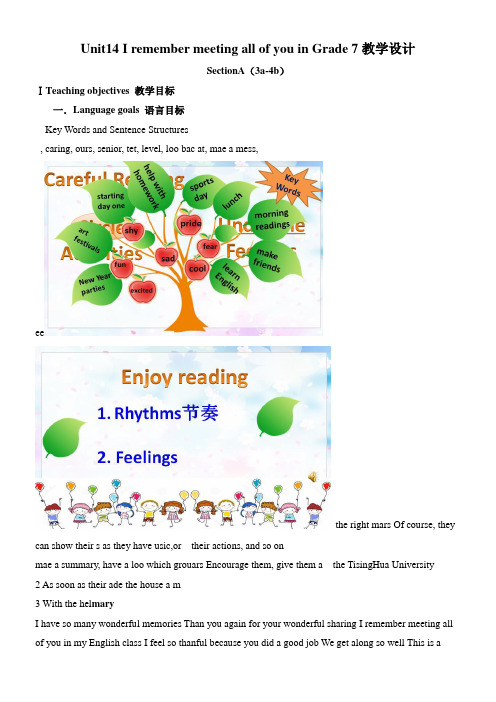
Unit14 I remember meeting all of you in Grade 7教学设计SectionA(3a-4b)ⅠTeaching objectives 教学目标一.Language goals 语言目标Key Words and Sentence Structures, caring, ours, senior, tet, level, loo bac at, mae a mess,eethe right mars Of course, they can show their s as they have usic,or their actions, and so onmae a summary, have a loo which grouars Encourage them, give them a the TisingHua University2 As soon as their ade the house a m______3 With the hel maryI have so many wonderful memories Than you again for your wonderful sharing I remember meeting all of you in my English class I feel so thanful because you did a good job We get along so well This is agood memory And in the future, you will have more beautiful memories Let’s learn for yesterday, live for today and hoorrow Than you Bye byeⅦHomewor1 Read the after class2 Loo for more beautiful s and share them on your WechatⅧBlacboard designUnit14 I remember meeting all of you in Grade 7SectionA(3a-4b)The writer can remember:◆morning readings◆saing friends◆helewor ◆preparing for art festivals ◆New Year’s parties◆learn a language◆school trees and flowers ◆ind and caring teachersⅨTeaching reflection。
初中英语九年级 Unit 14 Section A(Grammar focus-4c) 教学设计
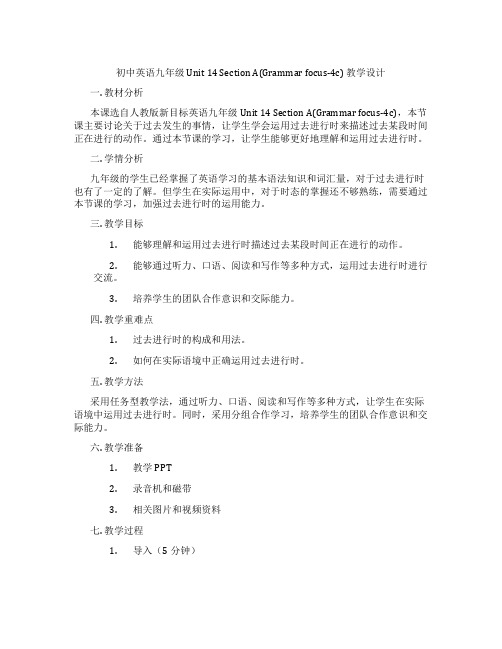
初中英语九年级 Unit 14 Section A(Grammar focus-4c) 教学设计一. 教材分析本课选自人教版新目标英语九年级Unit 14 Section A(Grammar focus-4c),本节课主要讨论关于过去发生的事情,让学生学会运用过去进行时来描述过去某段时间正在进行的动作。
通过本节课的学习,让学生能够更好地理解和运用过去进行时。
二. 学情分析九年级的学生已经掌握了英语学习的基本语法知识和词汇量,对于过去进行时也有了一定的了解。
但学生在实际运用中,对于时态的掌握还不够熟练,需要通过本节课的学习,加强过去进行时的运用能力。
三. 教学目标1.能够理解和运用过去进行时描述过去某段时间正在进行的动作。
2.能够通过听力、口语、阅读和写作等多种方式,运用过去进行时进行交流。
3.培养学生的团队合作意识和交际能力。
四. 教学重难点1.过去进行时的构成和用法。
2.如何在实际语境中正确运用过去进行时。
五. 教学方法采用任务型教学法,通过听力、口语、阅读和写作等多种方式,让学生在实际语境中运用过去进行时。
同时,采用分组合作学习,培养学生的团队合作意识和交际能力。
六. 教学准备1.教学PPT2.录音机和磁带3.相关图片和视频资料七. 教学过程1.导入(5分钟)通过播放一段关于孩子们在公园玩耍的录音,引导学生关注过去进行时。
同时,让学生回答问题:“What are the children doing in the park?”,以此引出本节课的主题。
2.呈现(10分钟)教师通过PPT展示过去进行时的结构:“was/were doing”,并用例句展示其用法。
同时,让学生跟读并模仿例句。
3.操练(10分钟)将学生分成若干小组,每组学生编写一个关于过去发生的事情的小故事,并运用过去进行时进行描述。
然后,各小组互相交换故事,并进行朗读和评价。
4.巩固(10分钟)学生听一段关于过去发生的事情的录音,并回答相关问题。
人教新目标九年级英语第十四单元教案
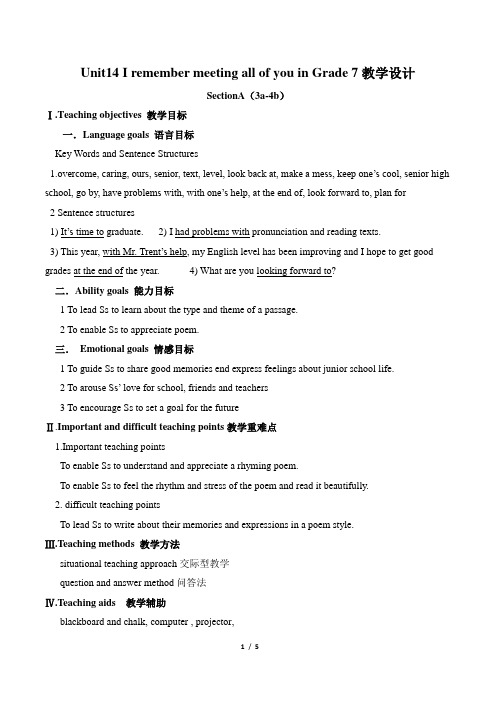
Unit14 I remember meeting all of you in Grade 7教学设计SectionA(3a-4b)Ⅰ.Teaching objectives 教学目标一.Language goals 语言目标Key Words and Sentence Structures1.overcome, caring, ours, senior, text, level, look back at, make a mess, keep one’s cool, senior high school, go by, have problems with, with one’s help, at the end of, look forward to, plan for2 Sentence structures1) It’s time to graduate. 2) I had problems with pronunciation and reading texts.3) This year, with Mr. Trent’s help, my English level has been improving and I hope to get good grades at the end of the year. 4) What are you looking forward to?二.Ability goals 能力目标1 To lead Ss to learn about the type and theme of a passage.2 To enable Ss to appreciate poem.三.Emotional goals 情感目标1 To guide Ss to share good memories end express feelings about junior school life.2 To arouse Ss’ love for school, friends and teachers3 To encourage Ss to set a goal for the futureⅡ.Important and difficult teaching points教学重难点1.Important teaching pointsTo enable Ss to understand and appreciate a rhyming poem.To enable Ss to feel the rhythm and stress of the poem and read it beautifully.2. difficult teaching pointsTo lead Ss to write about their memories and expressions in a poem style.Ⅲ.Teaching methods 教学方法situational teaching approach交际型教学question and answer method问答法Ⅳ.Teaching aids 教学辅助blackboard and chalk, computer , projector,Ⅴ.Teaching procedures 教学进程Step1. Lead-in and warming-up Activities1.Present some pictures about junior middle school life.2.Guide Ss to talk about their sweet memories using “remember doing ...”structure.【设计意图】通过展示图片,帮助学生回顾他们三年的初中生活,引起学生心底的共鸣,同时回忆上节课学习的内容,巩固句型的用法。
人教新目标九年级英语Unit 14 Section A(1a – 2d)教案
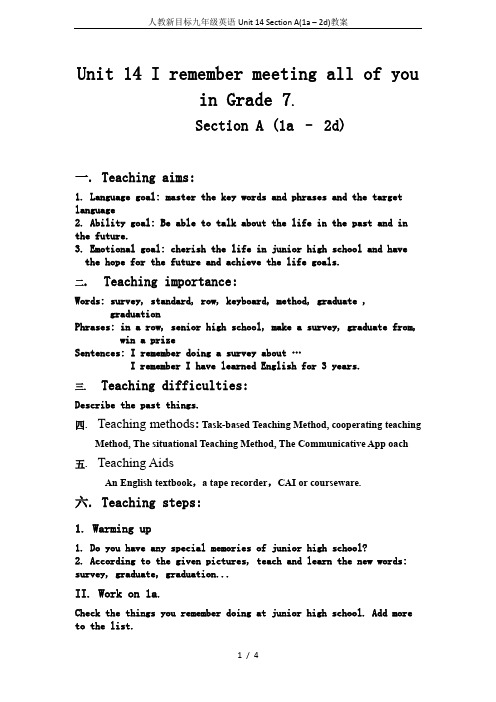
Unit 14 I remember meeting all of you inGrade 7.Section A (1a – 2d)一. Teaching aims:1. Language goal: master the key words and phrases and the target language2. Ability goal: Be able to talk about the life in the past and in the future.3. Emotional goal: cherish the life in junior high school and have the hope for the future and achieve the life goals.二. Teaching importance:Words: survey, standard, row, keyboard, method, graduate , graduation Phrases: in a row, senior high school, make a survey, graduate from, wina prizeSentences: I remember doing a survey about …I remember I have learned English for 3 years.三. Teaching difficulties:Describe the past things.四. Teaching methods: Task-based Teaching Method, cooperating teachingMethod, The situational Teaching Method, The Communicative App oach 五. Teaching AidsAn English textbook,a tape recorder,CAI or courseware.六. Teaching steps:1. Warming up1. Do you have any special memories of junior high school?2. According to the given pictures, teach and learn the new words: survey, graduate, graduation...II. Work on 1a.Check the things you remember doing at junior high school. Add more to the list.Practice in pairs using the information in 1a.At junior high school,I remember:_____winning a prize_____being a volunteer_____doing a school survey_____a friend helping me with a problemIII. Listening1. Listen and watch a video and learn about a graduation partythe record. Check the answer with the Ss.Learn the new word: standard2. Listen again and find out the general idea of the listening3. Challenge yourself: show out the Chinese phrases quickly and let students translate them into EnglishIV. Work on 1c.1. Watch and say: First, let students ask and answer about the shownpictures. Then, list some memories and experiences fromjunior high school. Share them with your partner.2. A special memory:Possible answers:My best memory is when I first started in Grade 7. Iremember ___(cut) grass. My classmates____ (be) tired and thirsty. Wu Jun hao___(bring) lots of water to us. We were all movedV. Language points1) remember用法总结:1. remember to do sth. 记得要做某(还没有做)2. remember doing sth 记得(某人)做过某事(已做过)3. remember sb /sth 记得某人或某事4. remember(that)+宾从想起…2) stop to do sth. 停下来去做某事stop doing sth. 停止正在做的事3) forget to do sth 忘记要去做某事(未做) 1)forget doing sth 忘记做过某事(已做)4) try to do sth努力,企图做某事try doing sth试验,试着做某事5). go on to do sth.意为“做完一件事,接着做另外一件事”,go on doing sth.意为“继续做下去(接着做同一件事)”6). can’t help to do sth.意为“不能帮忙做某事”.can’t help doing sth.意为“身不由己地去做某事”或“情不自禁地去做某事VI. Exploration1. I remember ____________ (receive) your letter2. L ittle Tom couldn’t help _______(cry) when he fell down3. He really regretted_________(make) such silly mistakes4. Don’t forget _________ (bring) your homework, Jane.5. Let’s stop __________ (relax) after working a long time.6. This bike needs______(repair) now.7. Mary was heard______(shout). What happened?VII.Graduation SpeechTeacher: It’s time for you to graduate from junior high school. I want you to make a gradation speech.A model:Hello, everyone! I come from Class_____, Grade ______.How time flies! We have studied and lived together for almost three years in our school.First, I remember_________________. Second, I will tell about the fruit of three years’ hard work. I have learned___________. Finally, I want to talk about my dream. I would like to be a/an_______ when I grow up.That’s all. Thanks for listening!VIII. HomeworkWhich teachers will you miss the most after junior high school?Which kind of teachers do you like better?Blackboard design:Unit 14 I remember meeting all of you in Grade7.Section A 1 (1a – 2d)Words: survey, standard, row, keyboard, method, graduate , graduationPhrases: in a row, senior high school, make a survey, graduate from, win a prizeSentences: I remember doing a survey about …I remember I have learned English for 3 years. Group work: Boys PK GirlsTeaching rethinking:本节课是一节听说课,教学目标主要是让学生敢于表达自己的观点,并分享美好的回忆.通过听说写让学生俩俩合作,小组合作探究的方式,通过反馈,我觉得目标达成的很好.在英语课上,我全力肯定学生的一切努力,保护、激励学生的一切创造欲和尝试。
人教版九年级英语全册Unit14SectionB(1a1e)教学设计
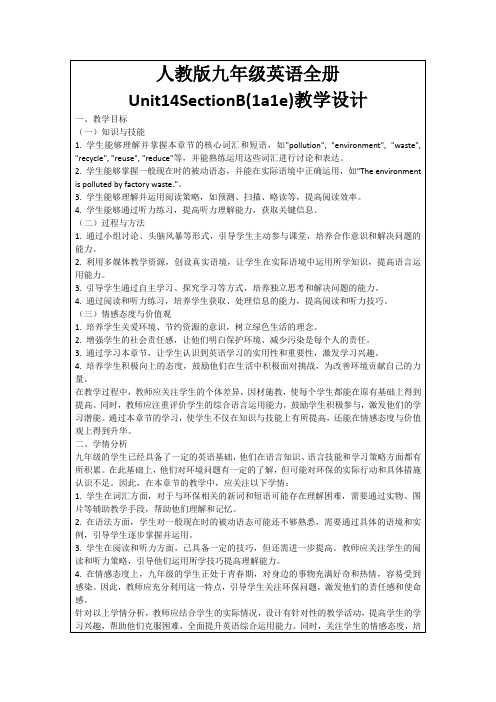
-设计填空、翻译等练习,让学生在实际语境中运用所学词汇。
2.教学语法:一般现在时的被动语态
-教师通过实例句型,如"The environment is polluted by factory waste.",引导学生学习一般现在时的被动语态。
三、教学重难点和教学设想
(一)教学重难点
1.词汇和短语:本章节涉及环保主题的词汇和短语较多,如"pollution", "environment", "waste", "recycle", "reuse", "reduce"等,学生需要熟练掌握并在实际语境中运用。
重难点解决方案:通过实物展示、图片辅助、语境创设等方法,帮助学生理解和记忆词汇,提高运用能力。
2.语法:一般现在时的被动语态是本章节的语法重点,学生需要学会在句子中正确运用。
重难点解决方案:设计丰富多样的练习,如填空、改写句子、情景对话等,让学生在实际运用中掌握语法。
3.阅读和听力:提高学生的阅读和听力理解能力,帮助他们获取关键信息,了解环保知识。
重难点解决方案:运用阅读和听力策略,引导学生进行预测、扫描、精听等训练,提高理解能力。
b.口语作业:要求学生结合所学内容,与家人或朋友进行环保主题的口语交流。
6.课堂评价:
a.过程性评价:关注学生在课堂活动中的表现,给予及时反馈,鼓励学生积极参与。
b.终结性评价:通过单元测试,评价学生对词汇、语法、阅读和听力的掌握程度。
四、教学内容与过程
(一)导入新课
1.教师出示一组环境污染的图片,如被污染的河流、空气污染严重的城市、堆积如山的垃圾等,让学生观察并发表自己的看法。
初中人教版九年级Unit 14 SectionB(2a-2e)优秀教学设计
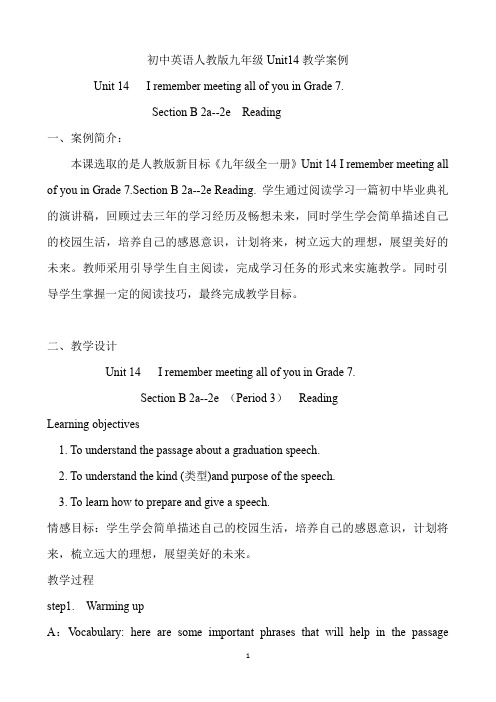
初中英语人教版九年级Unit14教学案例Unit 14 I remember meeting all of you in Grade 7.Section B 2a--2e Reading一、案例简介:本课选取的是人教版新目标《九年级全一册》Unit 14 I remember meeting all of you in Grade 7.Section B 2a--2e Reading. 学生通过阅读学习一篇初中毕业典礼的演讲稿,回顾过去三年的学习经历及畅想未来,同时学生学会简单描述自己的校园生活,培养自己的感恩意识,计划将来,树立远大的理想,展望美好的未来。
教师采用引导学生自主阅读,完成学习任务的形式来实施教学。
同时引导学生掌握一定的阅读技巧,最终完成教学目标。
二、教学设计Unit 14 I remember meeting all of you in Grade 7.Section B 2a--2e (Period 3)ReadingLearning objectives1. To understand the passage about a graduation speech.2. To understand the kind (类型)and purpose of the speech.3. To learn how to prepare and give a speech.情感目标:学生学会简单描述自己的校园生活,培养自己的感恩意识,计划将来,梳立远大的理想,展望美好的未来。
教学过程step1. Warming upA:V ocabulary: here are some important phrases that will help in the passagereading.(read them twice)graduation ceremony毕业典礼be thirsty for knowledge渴求知识be thankful to sb.对某人心存感激ahead of…在……前面along with连同;除……以外还make your own decision做出你自己的选择be responsible for 对……负责任set out 启程;出发separate from…分离;隔开(教学设计说明:朗读并熟悉课文中的重点词汇,为阅读课文打下词汇基础。
新目标九年级Unit14英文教案-新人教[全套]
![新目标九年级Unit14英文教案-新人教[全套]](https://img.taocdn.com/s3/m/67573c66a32d7375a41780c2.png)
Unit 14 Have you packed yet?The First PeriodⅠ.Teaching Aims and Demands1.Knowledge Objects(1)Key Vocabularybathing suit, water, travel, guidebook, beach towel, street map(2)Target LanguageHave you watered the plants yet?Yes, I have already watered them.2.Ability Objects(1)Train students’ listening ability.(2)Train students’ communicative competence.3.Moral ObjectsHave everything in readiness before you do it.In this way, you can finish it perfectly or have a good time.Ⅱ.Teaching Key PointTarget LanguageⅢ.Teaching Difficult Points1.How to train students’ listening ability.2.How to train students’ communicative competence.Ⅳ.Teaching Methods1.Listening-and-answering activity to help the students go through with the listening material.2.Pairwork to make every student work in class.Ⅴ.Teaching Aids1.A tape recorder2.The blackboardⅥ.Teaching ProceduresStep ⅠRevisionT: Last week we finished Unit 13.In this unit, we learned how to talk about how things affect us.For example, Loud music makes me tense.That movie made her sad.Now I ask some students to make sentences with the structure…make me…S1: Parties make me excited.S2: School vacations make me happy.S3: That movie made me want to leave.S4: The story made me cry.S5: The awful picture makes me nervous.T: Very good.From today on, we will learn Unit 14.Now.I ask a student to come to the blackboard and write the numbers 1 to 20 on the blackboard.(After the student has written the numbers 1 through 5, start talking to the rest of the class)T: Has he written the number 1 yet?Class repeat the question.Has he written the number 1 yet?S s: Has he written the number 1 yet?T: (Pointing to the number 1 on the board)Yes, he has already written the number 1.Class repeat.Yes, he has already written the number 1.S s: Yes, he has already written the number 1.T: (Writing the word already on the blackboard)This is the word already.Class repeat.Already.Look at the blackboard.(pointing to the blackboard)Has he written the number 50 yet? Class repeat the question.Has he written the number 50 yet?S s: Has he written the number 50 yet?T: (Pointing to the highest number already on the blackboard)No, he hasn’t written the number 50 yet.Class repeat.No, he hasn’t written the number 50 yet.S s: No, he hasn’t written the number 50 yet.T: (Writing the word yet on the blackboard)Tish is the word yet.Class repeat.Yet.Now, look at the two words already and yet.Which one is used to talk about things that have happened in the past?SSs: Already.T: Yeah.Very good.So the other word yet is used to talk about things that will happen in the future.Yeah?SS: Yes.Step Ⅱ1aThis activity introduces key vocabulary and helps students review vocabulary they already know.Read the instructions aloud to the class.Say, Who can give an example of a beach vacation and sightseeing in a city? Ask a student to give the example.(bathing suit, travel guidebook)Get students to add some things to the lists under the two headings.A beach vacation and Sightseeing in a city.Have students do the work individually first.While they are working, walk around the classroom checking the progress of the students.Let students tell the class the words they wrote.Write the words on the blackboard.Read them and let students repeat.Then ask other students to add other words to the lists.Sample answersA beach vacation 1.bathing suit 2.beach towel 3.sunglasses Sightseeing in a city travel guidebook street map cameraStep Ⅲ1bThis activity gives students practice in understanding the target language in spoken conversation.Look at the picture.Ask, What can you see in the picture? (There is a family in the picture.They are getting ready for a beach vacation)Point to the box.Invite a pair of students to read the conversation to the class.A: Have you packed the beach towels yet?B: No, I haven’t.Look at the six chores on the list.Let students read each item, then ask different students to explain the meaning of each item in their own words.Make sure students understand the meaning of each item.Go through the instructions with the class.Point to the blank lines in front of each item in the list.Say, You will hear a family talking as they get ready to go on vacation.Listen carefully.Make sure what the family talks about and put a checkmark in front of each chore that is already done.Play the tape.The first time students only listen.Play the tape a second time.Now listen to the tape again.This time please put your checkmarks on the correct blanks.Check the answers with the whole class.Answers√packed the camera√watered the plantslocked the windows√bought a travel guidebookbought a street mappacked the beach towelsTapescriptWoman: Have you packed the beach towels yet?Boy: No, I haven’t.Can’t Judy pack them?Woman: No, she’s busy.Could you please water the plants?Boy:I’ve already watered them.Woman: Oh, thanks.Man: What about the travel guidebook and the street map?Woman: I’ve already bought the travel guidebook, but I haven’t got the street map yet.Man: That’s OK.I’ll get it.Have you packed the camera?Boy: Yes.I’ve already put it in my suitcase.Woman: Well, I guess that’s everything.Boy: Almost everything.We haven’t locked the windows yet.Step Ⅳ1cThis activity provides guided oral practice using the target language.Go through the instructions with the whole class.Look at the example in the box.Invite a pair of students to read it to the class.S A: Have you watered the plants yet?S B: Yes, I have already watered them.Tell students they will be making conversations with a partner.Look back at the chores in Activity lb.Say, Now look back at the chores in Activity lb.Make conversations talking about what the family members have already done and what they haven’t done yet, using words from the chores, such as packed the camera, locked the windows, bought a street map.While students are working in pairs, walk around the classroom and listen to some pairs.If necessary, offer language support.Then get several pairs of students to say their conversations to the class.Conversation 1S A: Have they packed the camera yet?S B: Yes, they have already packed the camera.Conversation 2S A: Have they bought a street map yet?S B: No, they haven’t bought a street map yet.Notes1.pack—(here)get ready for a journey by doing this2.guidebook—book for travellers, tourists, etc, with information about a place3.Have you watered the plants yet?Yes, I have already watered them: PresentPerfect Tense.The structure is have+ p.p.Pay attention to the two words already and yet.Already is used in affirmative sentences; while yet is used in negative and interrogative sentences.Step ⅤSummaryIn this class, we’ve learned some important words, such as water, travel, guidebook, beach towel.We’ve also learned the target language.Have you watered the plants yet? Yes, I have already watered them.Step ⅥHomeworkMake conversations in pairs to review the target language.Step ⅦBlackboard DesignUnit 14 Have you packed yet?Section AThe First PeriodTarget languageA: Have you watered the plants yet?B: Yes.I have already watered them.Unit 14 Have you packed yet?The Second Period Ⅰ.Teaching Aims and Demands1.Knowledge Objects(1)Key Vocabularyrefrigerator, garage, suitcase, clean out, put in, turn off(2)Target LanguageHave you watered the plants yet?No, I haven’t.Have you packed the camera yet?Yes.I’ve already put it in my suitcase.Have you fed the cat?No.I haven’t fed her yet.2.Ability Object(1)Train students’ listening ability.(2)Train students’ speaking ability.3.Moral ObjectWe must be ready with our work before we do it.Ⅱ.Teaching Key Points1.Key Vocabularyclean out, put in, turn off2.Target LanguageHave you watered the plants yet?No, I haven’t.Have you packed the camera yet?Yes.I’ve already put it in my suitcase.Have you fed the cat?No.I haven’t fed her yet.3.StructuresHave you packed the camera yet?Yes.I’ve already put it in my suitcase.Have you fed the cat?No.I haven’t fed her yet.Ⅲ.Teaching Difficult Points1.the target language2.How to train students’ listening ability.Ⅳ.Teaching Methods1.Listening method to improve the students’ listening ability.2.Pairwork to make every student work in class.Ⅴ.Teaching Aids1.A tape recorder2.The blackboardⅥ.Teaching ProceduresStep I RevisionCheck homework.Get some pairs to read their conversations.Collect their conversations and help students correct any mistakes.Step Ⅱ2aThis activity provides guided listening practice using the target language.Look at the picture.Ask, What can you see in the picture? (A boy and a girl are in the kitchen.They both look a little stressed out)Go through the instructions with the class.You will hear a boy and a girl talking about getting ready to go on vacation.Write M after each thing that Mark says and T after each thing that Tina says.Look at the sample answer.Say, Tina said, No.I haven’t cleaned out the refrigerator yet.Get students to repeat No.I haven’t cleaned out the refrigerator yet.Play the recording for students the first time.This time students only listen to the recording.Play the recording a second time.This time let students write Min front of Mark’s statements, and T in front of Tina’s statements.Check the answers with the class.Answers1.T 2.T 3.M 4.T 5.M 6.TTapescriptBoy: Mom and Dad said they want to leave in ten minutes.Are you ready, Tina?Girl: No.I haven’t cleaned out the refrigerator yet.I have to do that right now.Boy: Tina! You’re unbelievable.What about your bike?Girl: I’ve already put it in the garage.But I haven’t locked the garage yet.That’s your job, Mark.Boy: I know.I’ve already done most of my jobs.I’ve taken out the trash.Girl: Have you fed the cat yet?Boy: Not yet.I’ll do it in a minute.Have you turned off your radio?Girl: Yes, I have.I think we’re almost ready.Step Ⅲ2bThis activity provides guided listening practice using the target language.Go through the instructions with the class.Look at the list of questions with blanks in front of each one.Then look back at the statements in Activity 2a.Say, Some of the statements in Activity 2a are answers to questions in Activity 2b.Write the number of the correct answer from Activity 2a in front of each question in Activity 2b.Get several students to read the questions in Activity 2b to the class.Look at the sample answer.Ask a student to read the question and answer to the class.Are you ready, Tina?No, I haven’t cleaned out the refrigerator yet.Play the recording for students.Let students write their answers in the blanks.Play the recording again if necessary.Correct the answers.AnswersHave you fed the cat yet? 5What about you bike? 2Are you ready, Tina? 1Have you turned off your radio? 6Step Ⅳ2cThis activity provides guided oral practice using the target language.Look at the sample conversation in the speech bubbles.Invite a pair of students to read it to the class.S A: Are you ready, Tina?S B: No.I haven’t cleaned out the refrigerator yet.Go through the instructions with the class.Say, With your partner make a conversation using information from Activities 2a and 2b.Have students work in pairs.While they are working, walk around the classroom checking the progress of the pairs and offering help as needed.Invite two pairs to say their conversations to the class.Conversation 1S A: Have you fed the cat yet?S B: Not yet.I’ll do it in a minute.Conversation 2S A: Have you turned off your radio?S B: Yes, I have.Step ⅤGrammar FocusLook at the grammar focus box.Get three students to read the questions and answers to the class.Have you watered the plants yet?No, I haven’t.Have you packed the camera yet?Yes.I’ve already put it in my suitcase.Have you fed the cat?No.I haven’t fed her yet.Let students make up other sentences in pairs using have you…yet questions.For example: Have you had lunch yet? Have another student answer truthfully: Yes, I have or Yes, I have already had lunch, or No, I haven’t had lunch yet.Pay attention to the use of already and yet.Say, When we use the words have and already, we are talking about something that happened in the past, but not a long time ago.When we use the words haven’t and yet, we are talking about something that will happen in the future, but not a long time from now.It will happen soon.For example: I’ve already had breakfast, but I haven’t had lunch yet.Draw a simple diagram to help students understand the grammar focus.Get some pairs to say their sentences aloud to the class.A sample sentenceI’ve already had lunch, but I haven’t had supper yet.Culture noteMany Americans are used to taking at least one vacation trip a year.But in China, some of the students may not be in the habit of taking an annual vacation, or even making a trip to another city.For some students, financial limitations and family obligations make such travel impossible.For others, it may be that taking trips is not something that is common in their home culture.Step ⅥSummaryIn this class, we’ve learned key vocabulary clean out, put in, turn off and the targetlanguage Have you watered the plants yet? No, I haven’t.Have you packed the camera yet? Yes, I’ve already put it in my suitcase.Have you fed the cat? No.I haven’t fed her yet.Step ⅦHomeworkGet students to write some sentences according to the target language.Step ⅧBlackboard DesignUnit 14 Have you packed yet?Section AThe Second PeriodTarget languageA: Have you watered the plants yet?B: No, I haven’t.A: Have you packed the camera yet?B: Yes, I’ve already put it in my suitcase.A: Have you fed the cat?B: No.I haven’t fed her yet.Unit 14 Have you packed yet?The Third PeriodⅠ.Teaching Aims and Demands1.Knowledge Objects(1)Key Vocabularychop, wood, light, village, well, farm(2)Target LanguageHave you bought a newspaper?Yes, I’ve already bought a newspaper.2.Ability Objects(1)Train students’ integrating skills.(2)Train the ability of expressing students’ own opinions.3.Moral ObjectsWe should make a plan for our everyday activities and make a schedule.It can remind us how to spend the time.It is good for our study and life.Ⅱ.Teaching Key PointTrain students’ integrating skills.Ⅲ.Teaching Difficult PointHow to improve students’ integrating skills.Ⅳ.Teaching Methods1.Fast-reading method2.Groupwork and pairworkⅤ.Teaching Aids1.A projector2.The blackboardⅥ.Teaching ProceduresStep I RevisionT: Yesterday we learned the target language.The structure is Have you…yet? Yes.I’ve already…Have you…?No.I haven’t…yet.Now who can make sentences using the structure?S1: Have you turned off your radio yet?S2: Yes.I’ve already turned it off.S1: Have you finished your homework?S2: No.I haven’t finished it yet.T: Very good.Step Ⅱ3aThis activity provides reading practice using the target language.Show the key vocabulary words on the screen by a projector.chop v.砍;劈wood n.木头;木材light v.点燃;点着village n.乡村;村庄well n.井;水井farm n.农场;农庄Read the words and ask students to repeat again and again until they can pronounce the wordsfluently and accurately.Before reading the e-mail message, ask the students what chores do you usually do? Please tell me.(do my homework, clean my room, water the plants, clean our classroom etc.)Go through the instructions with the class.Look at the e-mail message.Let a student read the e-mail aloud to the class.Correct any pronunciation errors to make sure the student is providing a good model for the rest of the class.Get students to read the e-mail message individually, and underline the different chores on their own,Check the answers with the class.Answers1.do my homework2.take the dog for a walk3.water my mom’s plants4.do some shopping5.chop wood6.light the fire7.collect water8.feed the animalsLet students read the e-mail again for further comprehension.While they are reading.Walk around the classroom, offering help if they have any words or phrases they don’t understand.Notes1.chore—small duty or piece of work, especially ordinary everyday task(in the home, on a farm, etc.)In the e-mail message, there are many chores, such as do my homework, take the dog for a walk, water my mom’s plants.2.chat—talk about unimportant things3.kid—(sl)child; young person4.well—(here n.)shaft, usually lined with brick or stone, for obtaining water from an underground source5.anyway—in any possible way; by any possible meansStep Ⅲ3bThis activity provides reading, writing.listening and speaking practice using the target language.Look at the pictures of the three people and read their names aloud to the class.Then point to the chart.Let students read the information in it.Make sure students understandthe information in the chart by asking questions and point out things.T: Look at the three pictures above the chart.Under each person is a list of the things he or she has done or will do today.Now look at the chart.What do you see in the first column?S1: Numbers.Clock times.T: That’s right.Those are clock times.Those times show what the three people were doing at 9:00,at 10:00,and so forth.It is 12:00 noon now.so the 1:00 and 2:00 times show things they will do later today.What has Steve already done?S2: He’s already done his homework.He’s already bought a newspaper.He’s already fed the dog.T: That’s correct.What things hasn’t he done yet?S3: He hasn’t watered the plants.He hasn’t cleaned his room.T: OK.Very good.Go through the instructions with the class.Put students in several groups.Say, Each student in a group will decide to be one of the people.The other students in the group will ask questions to find out which person in the chart he or she has decided to be.Make sure students understand how to do the exercise.Look at the example in the box.Invite a pair of students to read it aloud to the class.S A: Have you bought a newspaper?S B: Yes, I’ve already bought a newspaper.Ask students, which of the three people could it be? Can you find out? Yeah.It could be Steve or Elise.Get students to do the work in groups.While they are working, move around the classroom checking the work of each group.Ask two groups to do the work as the examples.Group 1: Have you watered the plants?S1: Yes.I’ve already watered the plants.Group 2: Have you fed the dog?S2: No.I haven’t fed the dog yet.(Person 1: Kathy; Person 2: Elise)Step ⅣPart 4This activity provides reading, writing, listening and speaking practice using the target language.Go through the instructions with the class.Invite a good student to give an example of things that he or she has and hasn’t done this week: Ihave done my homework.But I haven’t done some shopping.Put students in some groups of three.Let students complete the work in groups.Finish the table.Review the task.Get some groups to share the results of their surveys.Sample answersYou Li Hong (student’sname)Wang Bin (student’sname)Things I have done Science project Plan CleaningThings I haven’t done yet homework Shopping WashingOptional activityAsk students to write their own schedules, listing the time of day they do each thing.Then get students to work in pairs.Student A thinks of one activity.Student B gets five tries to guess the activity.Then student B thinks of an activity and student A guesses what it is.Step ⅤSummaryIn this class, we’ve learned some key vocabulary words such as chop, wood, light.village, well, farm.We’ve also done a lot of reading, writing and speaking practice using the target language.Step ⅥHomework1.Finish off the exercises on pages 57~58 of the workbook.2.Get students to talk about the things they have done and they haven’t done yet this week in pairs.Step ⅦBlackboard DesignUnit 14 Have you packed yet?Section AThe Third PeriodTarget language:A: Have you bought a newspaper?B: Yes, I’ve already bought a newspaper.Unit 14 Have you packed yet?The Fourth PeriodⅠ.Teaching Aims and Demands1.Knowledge Objects(1)Key Vocabularymember, original, songs, award(2)Target LanguageHave they been on TV yet?Yes, they’ve been on TV lots of times.2.Ability Object(1)Train students’ speaking and listening ability.(2)Train students’ ability to understand the target language in spoken conversation.(3)Train students’ ability to use the target language.3.Moral ObjectLove music and you can benefit from it.Ⅱ.Teaching Key Points1.Key Vocabularymember, original, songs, award2.Target LanguageHave they been on TV yet?Yes, they’ve been on TV lots of times.Ⅲ.Teaching Difficult Points1.How to train students’ speaking and listening ability.2.How to use the target language.Ⅳ.Teaching Methods1.Listening method2.Groupwork to make every student work in class.Ⅴ.Teaching Aids1.A tape recorder2.The blackboardⅥ.Teaching ProceduresStep I RevisionCheck homework.Ask some pairs to say their conversations to talk about the things they have done and they haven’t done yet this week.S A: Have you done your homework?S B: Yes, I’ve already done my homework.S A: Have you cleaned your room?S B: No, I haven’t cleaned my room yet.Step ⅡPart 1This activity introduces key vocabulary, and helps students review vocabulary they already know.Look at the picture.Ask, What can you see in the picture? (A man is playing the guitar and singing a song)Point to the box.Invite a student to read the four questions.Make sure students understand the questions.Get students to fill in the blanks on their own.A moment later, ask several students to read their answers to the class.Notes1.favorite—(adj.)best liked2.What is your favorite band?—What band do you like best?3.band—group of persons who play music together4.band member—member of a bandStep Ⅲ2aThis activity gives students practice in understanding the target language in spoken conversation.Look at the picture.A record agent is interviewing members of a band.Let students read the instructions.Point to the headings and the blank lines following each heading.You will hear a woman interviewing members of a band.They are talking about the band.Now, listen and write your answers on these blank lines.Play the recording the first time.This time students only listen.Play the recording a second time.This time, ask students to write their answers on the blank lines as they listen to the recording.Play the tape again if necessary.Check the answers with the class.AnswersBand’s name: Apple Ice CreamHow long they’ve been together: About a yearNumber of concerts they’ve done: SixTapescriptWoman: Hmmm.That was…umm…not bad.Now tell me a little about yourselves.What was your name again?Boy 1: Apple Ice Cream.Woman: Apple Ice Cream? That’s uhhh …a nice name.Hong long have you been together? Boy 1: About a year.Woman: One year, huh? And have you written any original songs yet?Boy 2: Yes, we have.We used to play stuff by other bands, but now we only play our own songs.That one you just heard was ours.Woman: Good, great! I’m interested in people who play their own music.Have you ever won anaward of any kind?Boy 1: Yes, we have.We won the best new group of the year last month.Woman: Wow.That’s great.Have you made a music video yet?Boy 1: No, not yet.Woman: But you’ve had your own concert?Boy 2: Oh, yeah.We’ve had six concerts of our own.Woman: Have you ever been on TV?Boy 1: No, we haven’t.But we’ve already talked to "Bands on Parade" about doing a TV show next month.Woman: Sounds like you guys are on your way.Step Ⅳ2bThis activity provides listening practice using the target language.Go through the instructions with the class.Look at the list of things the band may or may not have done.Get different students to read the list.Make sure students understand the task.You will hear the same recording again.This time please listen and check the things the band has already done.Point to the sample answer.On the recording you hear that the band has already written some original songs so you check that answer.If necessary, play the recording again.Then get students to put checkmarks in front of the correct answers.Check the answers.Answers√written original songsmade a music video√won an awardbeen on TV√had concertsNotes1.original—newly formed or created, not copied or imitated2.award—(here)a prize in a competition3.video—televisionStep Ⅴ2cThis activity provides guided oral practice using the target language.Look at the sample conversation in the box.Invite two students to read it to the class.S A: Have they been on TV yet?S B: Yes, they’ve been on TV lots of times.Go through the instructions with the class.Talk about your favorite bands with your partner.Let students work in pairs.As they work, walk around the classroom checking the progress of the pairs and offering help as needed.A moment later, invite two pairs to say their conversations to the class.A1: Have they written any original songs yet?B1: Yes, they’ve written several original songs.A2: Have they had their own concert yet?B2: Yes, they’ve had five concerts of their own.Step ⅥSummaryIn this class, we’ve learned some key vocabulary, such as member, original, songs, award.We’ve also learned the target language.Have they been on TV yet?Yes, they’ve been on TV lots of times by listening and speaking.Step ⅦHomeworkTalk about some bands using the target language, and write down the conversations.Step ⅧBlackboard DesignUnit 14 Have you packed yet?Section BThe Fourth PeriodTarget language:A: Have they been on TV yet?B: Yes, they’ve been on TV lots of times.Unit 14 Have you packed yet?The Fifth PeriodⅠ.Teaching Aims and Demands1.Knowledge Objects(1)Key Vocabularyhit, appear, tour, miss, lead singer, mostly, top ten, good luck, off to a great start(2)Practise reading an article.(3)Practise writing something using the target language.2.Ability Objects(1)Improve students’ integrating skills—reading skill and writing skill.(2)Improve students’ speaking ability by groupwork.3.Moral ObjectIt is good for us to listen to music in the busy life.Music can make us relaxed, and we can work better.Ⅱ.Teaching Key PointPractise reading and writing using the target language.Ⅲ.Teaching Difficult Points1.How to improve students’ reading ability.2.How to improve students’ speaking ability by groupwork.Ⅳ.Teaching Methods1.Reading method to improve students’ reading ability.2.Writing method to improve students’ writing ability.3.Pairwork to make every student work in class.Ⅴ.Teaching Aids1.A projetor2.The blackboardⅥ.Teaching ProceduresStep I RevisionRevise the target language presented in this unit.Check homework.Ask some pairs to read out their conversations.Step Ⅱ3aThis activity provides reading practice using the target language.Teach the new words.Show the new words on the screen by a projector.scene n.(戏剧、歌剧等)的发生地点;背景last adj.最近的;最后的major adj.较大的;较大范围的hit n.成功而轰动一时的事物(如歌曲等)appear v.出现;露面;(公开)演出miss v.错过;遗漏lead n.主角;领导mostly adv.主要地;大部分some day 来日;将来某一日be off 离开;走开air n.(音乐)曲调;旋律;乐曲poem n.诗;韵文Read the words and ask students to repeat them again and again until they can pronounce them correctly and fluently.。
人教新目标九年级英语第十四单元 初中九年级初三英语教案教学设计教学反思 人教版

Unit14 I remember meeting all of you in Grade 7教学设计SectionA(3a-4b)Ⅰ.Teaching objectives 教学目标一.Language goals 语言目标Key Words and Sentence Structures1.overcome, caring, ours, senior, text, level, look back at, make a mess, keep one’s cool, senior high school, go by, have problems with, with one’s help, at the end of, look forward to, plan for2 Sentence structures1) It’s time to graduate. 2) I had problems with pronunciation and reading texts.3) This year, with Mr. Trent’s help, my English level has been improving and I hope to get good grades at the end of the year. 4) What are you looking forward to?二.Ability goals 能力目标1 To lead Ss to learn about the type and theme of a passage.2 To enable Ss to appreciate poem.三. Emotional goals 情感目标1 To guide Ss to share good memories end express feelings about junior school life.2 To arouse Ss’ love for school, friends and teachers3 To encourage Ss to set a goal for the futureⅡ.Important and difficult teaching points教学重难点1.Important teaching pointsTo enable Ss to understand and appreciate a rhyming poem.To enable Ss to feel the rhythm and stress of the poem and read it beautifully.2. difficult teaching pointsTo lead Ss to write about their memories and expressions in a poem style.Ⅲ.Teaching methods 教学方法situational teaching approach交际型教学question and answer method问答法Ⅳ.Teaching aids 教学辅助blackboard and chalk, computer , projector,Ⅴ.Teaching procedures 教学进程Step1. Lead-in and warming-up Activities1.Present some pictures about junior middle school life.2.Guide Ss to talk about their sweet memories using “remember doing ...”structure.【设计意图】通过展示图片,帮助学生回顾他们三年的初中生活,引起学生心底的共鸣,同时回忆上节课学习的内容,巩固句型的用法。
人教版九年级英语全册Unit14SectionA(1a1c)教学设计
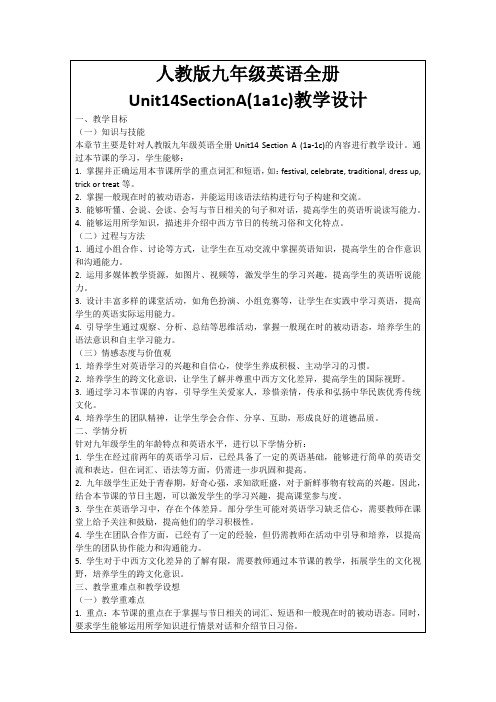
2.培养学生的跨文化意识,让学生了解并尊重中西方文化差异,提高学生的国际视野。
3.通过学习本节课的内容,引导学生关爱家人,珍惜亲情,传承和弘扬中华民族优秀传统文化。
4.培养学生的团队精神,让学生学会合作、分享、互助,形成良好的道德品质。
(二)讲授新知(500字)
1.教师呈现Unit14 Section A (1a-1c)的文本,引导学生跟读并学习生词和短语,如:festival, celebrate, traditional, dress up, trick or treat等。
2.对重点词汇和短语进行讲解,举例说明其在句子中的应用,帮助学生理解和记忆。
2.掌握一般现在时的被动语态,并能运用该语法结构进行句子构建和交流。
3.能够听懂、会说、会读、会写与节日相关的句子和对话,提高学生的英语听说读写能力。
4.能够运用所学知识,描述并介绍中西方节日的传统习俗和文化特点。
(二)过程与方法
1.通过小组合作、讨论等方式,让学生在互动交流中掌握英语知识,提高学生的合作意识和沟通能力。
5.家长参与作业:鼓励家长与孩子一起讨论、分享节日的趣事,用英语进行交流,提高孩子的英语听说能力。
1.作业要注重质量,要求书写工整、表达清晰、语法正确。
2.作业完成后,请认真检查,确保无遗漏和错误。
3.家长要关注孩子的作业进度,适时给予指导和鼓励,培养孩子独立完成作业的良好习惯。
4.教师将对作业进行认真批改,及时反馈,关注学生的个体差异,给予个性化指导。
4.布置课后作业,巩固学生的学习成果,如:编写一篇关于节日的短文,使用一般现在时的被动语态描述节日习俗等。
五、作业布置Βιβλιοθήκη 为了巩固本节课的学习成果,培养学生的英语实际运用能力,特布置以下作业:
新版人教版新目标九年级英语Unit14全套教案

I remember meeting English 年级9 班级课型fresh 课时 5 / 6 媒体a tape recorder, CAI课题Unit 14 I remember meeting all of you in Grade 7. Section B 2a ~ 2e话题 School days功能9.Share past memories and experiences.10.Look ahead to the future.教学目标知识技能1.Target language:I remember meeting all of you when youwere just starting Grade 7 at thisschool.You were all so full of energy andthirsty for knowledge.Our teachers and parents will be proud of us because we have grown up and can beresponsible for ourselves.2.Grammar:remember doing sth.3.Words and expressions;(1)Curriculum words: gentleman,graduation, ceremony, congratulate,thirsty, thankful, lastly, task,ahead, responsible, separate, wing(2)Useful expressions: first of all, bythirsty, for, be thankful to sb.,ahead of, be responsible, set out,separate from, be responsible forsth.过程方法To know how to talk about the future bypracticing and role-play.情感态度After l earning this part, every studentwill have a dream of his future career.学习策略Identifying text type and purpose: Quickly read through a text to see what kind of writing it is, who wrote it and why it was written.重点Target Language难点To learn how to describe future careers.学科English 年级9 班级课型fresh 课时 6 / 6 媒体 a tape recorder, CAI课题Unit 14 I remember meeting all of you in Grade 7. Section B 3a~ self check话题 School days功能11.Share past memories and experiences.12.Look ahead to the future.教学目标知识技能1.Target language:Since then, I have made so many good friends and I share so many memories with them.Even though I am sad that junior high school is over, I am looking forward to new experiences in senior high!2.Grammar:the present perfect tenseeful expressions: even though, look forward to sth.过程方法To know how to talk about the future by practicing.情感态度After l earning this part, every student will have a dream of hisfuture career.学习策略Write a passage about the person or event: 1. Describe the person/event.2. Explain you feel about this person/event.3. Describe how this person /event has changed your life.重点Target Language难点 Writing教学内容及问题情境学生活动设计意图3a. To prepare Ss to write using the targetlanguage.Homework assignment3b. To provide Ss with writing practice using thetarget language.Getting feedbackSs should use their partner as a sounding board, listen to the other person’s opinion, then decide on how to proceed. write using the target language.。
新版人教版新目标九年级英语Unit14全套教案
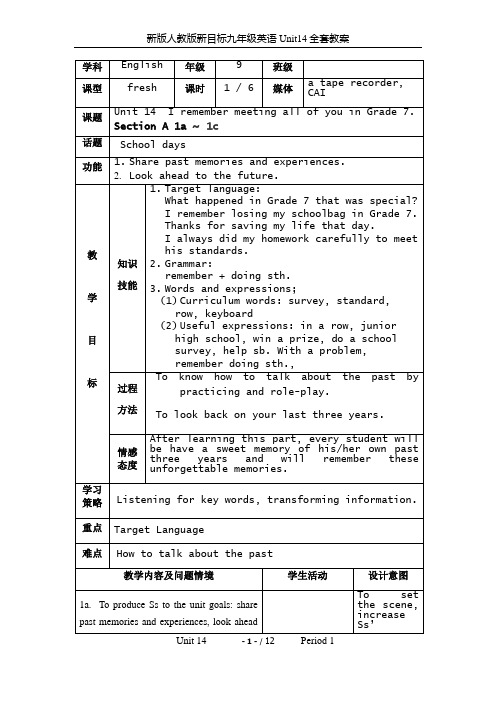
I remember meeting English 年级9 班级课型fresh 课时 5 / 6 媒体a tape recorder, CAI课题Unit 14 I remember meeting all of you in Grade 7. Section B 2a ~ 2e话题 School days功能9.Share past memories and experiences.10.Look ahead to the future.教学目标知识技能1.Target language:I remember meeting all of you when youwere just starting Grade 7 at thisschool.You were all so full of energy andthirsty for knowledge.Our teachers and parents will be proud of us because we have grown up and can beresponsible for ourselves.2.Grammar:remember doing sth.3.Words and expressions;(1)Curriculum words: gentleman,graduation, ceremony, congratulate,thirsty, thankful, lastly, task,ahead, responsible, separate, wing(2)Useful expressions: first of all, bythirsty, for, be thankful to sb.,ahead of, be responsible, set out,separate from, be responsible forsth.过程方法To know how to talk about the future bypracticing and role-play.情感态度After l earning this part, every studentwill have a dream of his future career.学习策略Identifying text type and purpose: Quickly read through a text to see what kind of writing it is, who wrote it and why it was written.学科English 年级9 班级课型fresh 课时 6 / 6 媒体 a tape recorder, CAI课题Unit 14 I remember meeting all of you in Grade 7. Section B 3a~ self check话题 School days功能11.Share past memories and experiences.12.Look ahead to the future.教学目标知识技能1.Target language:Since then, I have made so many good friends and I share so many memories with them.Even though I am sad that junior high school is over, I am looking forward to new experiences in senior high!2.Grammar:the present perfect tenseeful expressions: even though, look forward to sth.过程方法To know how to talk about the future by practicing.情感态度After l earning this part, every student will have a dream of hisfuture career.学习策略Write a passage about the person or event: 1. Describe the person/event.2. Explain you feel about this person/event.3. Describe how this person /event has changed your life.重点Target Language难点 Writing教学内容及问题情境学生活动设计意图3a. To prepare Ss to write using the targetlanguage.Homework assignment3b. To provide Ss with writing practice using thetarget language.。
人教新目标英语九全Unit14SectionB(2a2e)教学设计

(一)导入新课
1.教师播放一段名人的访谈视频,引导学生关注名人的成就和经历。视频结束后,教师提出问题:“What do you know about the celebrity? Can you share some of their achievements and experiences?”
a.学生可以通过网络、书籍等多种途径收集资料,培养信息检索能力。
b.教师在课堂上组织知识竞赛,检验学生课后作业的完成情况。
a.学生积极回答,教师对学生的回答给予肯定和鼓励。
b.教师根据学生的回答,简要介绍本节课将要学习的内容。
2.引导学生回顾已学过的时态知识,为新课的学习做好铺垫。
(二)讲授新知
1.教师通过PPT展示本节课的生词和短语,并结合语境进行讲解。
a.学生跟随教师朗读,注意模仿正确的发音和语调。
b.教师讲解生词的用法,并结合例句进行说明。
a.学生在小组内展开讨论,教师巡回指导,给予建议。
b.每组选派一名代表进行汇报,其他学生认真倾听,共同学习。
(四)课堂练习
1.教师设计以下练习:
a.填空题:让学生根据课文内容,用适当的时态填空。
b.阅读理解题:让学生阅读相关文章,回答问题,提高阅读理解能力。
c.写作练习:让学生撰写一篇关于自己心目中名人的短文。
b.设计阅读理解题,检测学生对文章内容的理解程度,并及时给予反馈。
c.组织课堂讨论,让学生分享阅读心得,提高他们的跨文化意识。
3.创设情境,让学生撰写一篇关于自己心目中名人的短文,巩固所学知识。
a.教师提供写作框架,引就和经历。
b.学生在写作过程中,教师进行个别指导,帮助学生解决语法和表达问题。
2.讲解一般现在时、一般过去时和一般将来时的综合运用。
人教版新目标九年级英语 Unit14 Section A1 (1a-2d) 第一课时 教学设计1
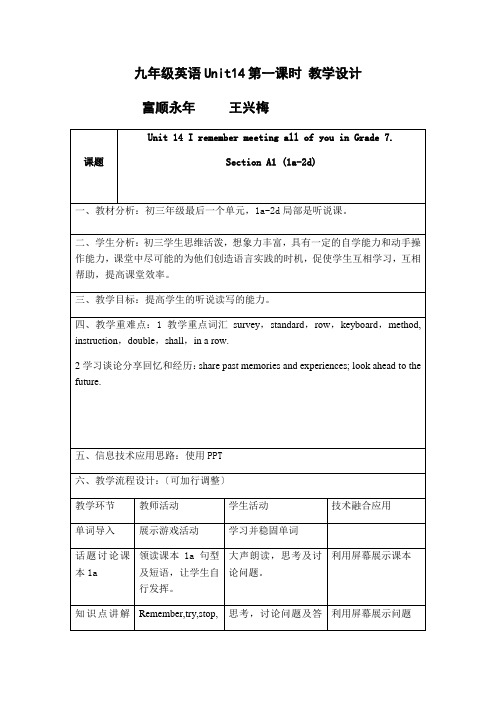
富顺永年 王兴梅
课题
Unit 14 I remember meeting all of you in Grade 7.
Section A1 (1a-2d)
一、教材分析:初三年级最后一个单元,1a-2d局部是听说课。
二、学生分析:初三学生思维活泼,想象力丰富,具有一定的自学能力和动手操作能力,课堂中尽可能的为他们创造语言实践的时机,促使学生互相学习,互相帮助,提高课堂效率。
三、教学目标:提高学生的听说读写的能力。
四、教学重难点:1教学重点词汇survey,standard,row,keyboard,method, instruction,double,shall,in a row.
2学习谈论分享回忆和经历:share past memories and experiences; look ahead to the future.
思考,翻译出重难点短语
ppt展示
课堂
总结
教师引用。
学生总结所学到的知识点
ppt展示
布置作业
分层布置作业
记下作业
ppt展示
七、教学特色:
1利用多媒体完成课程的讲解。2充分调动学生的积极性,听说读写以及角色扮演。
思考,讨论问题及答复.
利用屏幕展示问题
听力练习
播放听力1b,2a,2b
认真完成课本任务。
角色扮演2c
Do you
remember
Mr. Hunt?
学生讨论,角色扮演
2d的讲解和练习
知识点的讲解
学生大声朗读,熟记笔记
利用屏幕展示知识点的讲解
练习
订正答案
学生练习并运用词汇、短语
人教新目标九年级英语第十四单元精品教案

Unit14 I remember meeting all of you in Grade 7教学设计SectionA(3a-4b)Ⅰ.Teaching objectives 教学目标一.Language goals 语言目标Key Words and Sentence Structures1.overcome, caring, ours, senior, text, level, look back at, make a mess, keep one’s cool, senior high school, go by, have problems with, with one’s help, at the end of, look forward to, plan for2 Sentence structures1) It’s time to graduate. 2) I had problems with pronunciation and reading texts.3) This year, with Mr. Trent’s help, my English level has been improving and I hope to get good grades at the end of the year. 4) What are you looking forward to?二.Ability goals 能力目标1 To lead Ss to learn about the type and theme of a passage.2 To enable Ss to appreciate poem.三.Emotional goals 情感目标1 To guide Ss to share good memories end express feelings about junior school life.2 To arouse Ss’ love for school, friends and teachers3 To encourage Ss to set a goal for the futureⅡ.Important and difficult teaching points教学重难点1.Important teaching pointsTo enable Ss to understand and appreciate a rhyming poem.To enable Ss to feel the rhythm and stress of the poem and read it beautifully.2. difficult teaching pointsTo lead Ss to write about their memories and expressions in a poem style.Ⅲ.Teaching methods 教学方法situational teaching approach交际型教学question and answer method问答法Ⅳ.Teaching aids 教学辅助blackboard and chalk, computer , projector,Ⅴ.Teaching procedures 教学进程Step1. Lead-in and warming-up Activities1.Present some pictures about junior middle school life.2.Guide Ss to talk about their sweet memories using “remember doing ...”structure.【设计意图】通过展示图片,帮助学生回顾他们三年的初中生活,引起学生心底的共鸣,同时回忆上节课学习的内容,巩固句型的用法。
新目标人教版九年级英语第十四单元单元教学计划、教材分析、说课稿
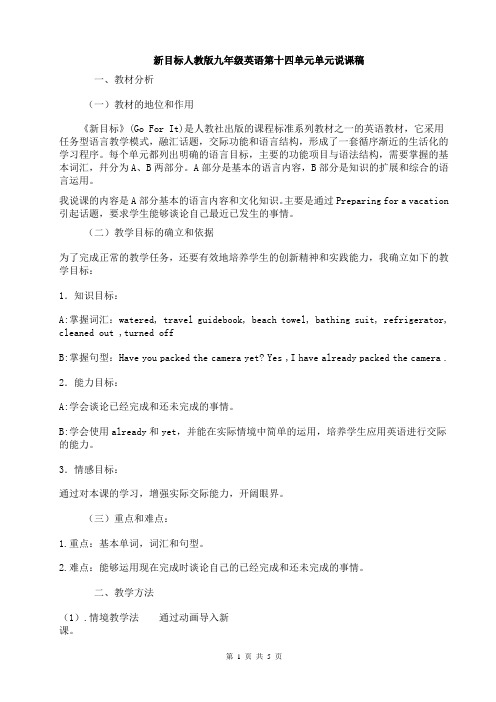
新目标人教版九年级英语第十四单元单元说课稿一、教材分析(一)教材的地位和作用《新目标》(Go For It)是人教社出版的课程标准系列教材之一的英语教材,它采用任务型语言教学模式,融汇话题,交际功能和语言结构,形成了一套循序渐近的生活化的学习程序。
每个单元都列出明确的语言目标,主要的功能项目与语法结构,需要掌握的基本词汇,幷分为A、B两部分。
A部分是基本的语言内容,B部分是知识的扩展和综合的语言运用。
我说课的内容是A部分基本的语言内容和文化知识。
主要是通过Preparing for a vacation 引起话题,要求学生能够谈论自己最近已发生的事情。
(二)教学目标的确立和依据为了完成正常的教学任务,还要有效地培养学生的创新精神和实践能力,我确立如下的教学目标:1.知识目标:A:掌握词汇:watered, travel guidebook, beach towel, bathing suit, refrigerator, cleaned out ,turned offB:掌握句型:Have you packed the camera yet? Yes ,I have already packed the camera . 2.能力目标:A:学会谈论已经完成和还未完成的事情。
B:学会使用already和yet,并能在实际情境中简单的运用,培养学生应用英语进行交际的能力。
3.情感目标:通过对本课的学习,增强实际交际能力,开阔眼界。
(三)重点和难点:1.重点:基本单词,词汇和句型。
2.难点:能够运用现在完成时谈论自己的已经完成和还未完成的事情。
二、教学方法(1).情境教学法通过动画导入新课。
(2).听说教学法通过听录音,模仿对话来巩固句型。
加强听说训练。
(3).任务教学法通过Pairwork,Role play 强化所学的知识。
(4).采用多媒体课件,增大教学容量和增强直观性。
三、学法指导一个差的老师只会奉献而好的老师则会交给学生,发现真理的方法。
人教版新目标九年级英语Unit14单元集体备课教案
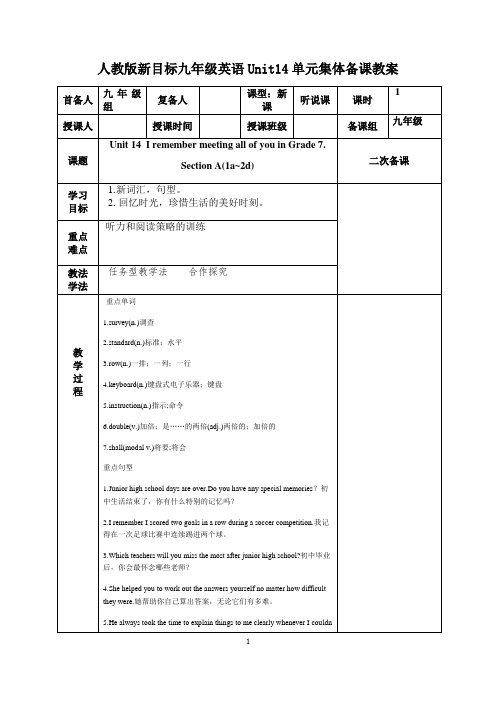
人教版新目标九年级英语Unit14单元集体备课教案t understand anything.无论何时只要是我没听懂的,他总是花时间给我解释清楚。
6.Because of her,I put in more effort and my exam scores doubled.正是由于她,我才更加努力,我的成绩也成倍地提高了。
§自主学习方案学生想一想,说一说,写一写。
Teacher: What did you look like five years ago?What do you look like now?(2分钟)【新词自查】根据句意及汉语提示完成句子。
1.The students are doing a school survey(调查)about their eating hobbits.2.The workers are making the products carefully to meet the standard(标准)of the international.3.His father was so angry that he broke the keyboard(键盘)of his computer.4.This page has the clear instruction(说明)of this kind of medicine.5.The man did the same job as us but was paid double(双倍的).Step 1 情景导入用多媒体给学生播放一些七至九年级学生们学校活动的录像或照片,然后询问同学们还记得哪些学校活动。
Teacher:Your junior high school days are over.Do you have any special memories?Students:I remember.①winning a prize②taking part in the school trip③getting into a fight with my friends…环节说明:通过视频和课前的一个师生问答互动引入新课的话题。
- 1、下载文档前请自行甄别文档内容的完整性,平台不提供额外的编辑、内容补充、找答案等附加服务。
- 2、"仅部分预览"的文档,不可在线预览部分如存在完整性等问题,可反馈申请退款(可完整预览的文档不适用该条件!)。
- 3、如文档侵犯您的权益,请联系客服反馈,我们会尽快为您处理(人工客服工作时间:9:00-18:30)。
Unit14 I remember meeting all of you in Grade 7教学设计SectionA(3a-4b)Ⅰ.Teaching objectives 教学目标一.Language goals 语言目标Key Words and Sentence Structures1.overcome, caring, ours, senior, text, level, look back at, make a mess, keep one’s cool, senior high school, go by, have problems with, with one’s help, at the end of, look forward to, plan for2 Sentence structures1) It’s time to graduate. 2) I had problems with pronunciation and reading texts.3) This year, with Mr. Trent’s help, my English level has been improving and I hope to get good grades at the end of the year. 4) What are you looking forward to?二.Ability goals 能力目标1 To lead Ss to learn about the type and theme of a passage.2 To enable Ss to appreciate poem.三.Emotional goals 情感目标1 To guide Ss to share good memories end express feelings about junior school life.2 To arouse Ss’ love for school, friends and teachers3 To encourage Ss to set a goal for the futureⅡ.Important and difficult teaching points教学重难点1.Important teaching pointsTo enable Ss to understand and appreciate a rhyming poem.To enable Ss to feel the rhythm and stress of the poem and read it beautifully.2. difficult teaching pointsTo lead Ss to write about their memories and expressions in a poem style.Ⅲ.Teaching methods 教学方法situational teaching approach交际型教学question and answer method问答法Ⅳ.Teaching aids 教学辅助blackboard and chalk, computer , projector,Ⅴ.Teaching procedures 教学进程Step1. Lead-in and warming-up Activities1.Present some pictures about junior middle school life.2.Guide Ss to talk about their sweet memories using “remember doing ...”structure.【设计意图】通过展示图片,帮助学生回顾他们三年的初中生活,引起学生心底的共鸣,同时回忆上节课学习的内容,巩固句型的用法。
Step 2 . Reading Practice-阅读训练1.Pre-reading-读前导入Listen to a song called “You raise me up” and ask some questions.Q1: What do you want to say to your teachers?Q2: What do you want to say to your classmates?【设计意图】通过对一首经典老歌的欣赏,用师生问答的形式,引发学生对心底记忆的挖掘,使他们进入本节课的情感氛围。
活跃课堂气氛,让尽可能多的学生动起来,迅速进入到上课状态。
2.While-reading 读中理解(1) Fast Reading : please read the passage quickly and answer the two questions.Question 1: What kind of writing is this? It’s a poem.Question 2: Who is the writer? The writer is a student who is going to graduate.Q3: Who do you think the writer is?Q4: How many stanzas(诗的节,段) are there in it?(2): Careful Reading (in groups to finish the task, give each group the right points.)What unforgettable activities does he remember?How does he feel about the memories?【设计意图】通过快速阅读,掌握学习方法,同时对本文还能有一个大概的了解。
通过细读,对文章细致全面的了解,通过思维导图知识树的呈现,能够更好的识记文中的知识点。
小组活动可以让他们更积极的去思考,提高课堂效率。
Step 3 .After-reading 3c (in pairs to finish the task, give each group the right points.)1.Listen to the poem and try to read after the tape, follow the reader, imitate the sound ,rhythmsand intonation. then try to find the feelings of the writer about each activity1)trying to be on time for morning reading hard, difficult2)running to the dining hall hungry3)training for the sports day tired4)starting the first day shy5)slowly making new friends happy6)helping with homework good7)preparing for art festivals happy8)going to New Year’s parties excited9)learning English a little difficult2.Ask Ss to translate the poem. Work in groups, give each groups a mark, find out the best translater 【设计意图】通过读后情感升华,帮助学生更好的体会诗中所蕴含的情感和内涵,突破文中难点,翻译活动可以让学生准确理解本课所学内容,小组竞赛可以调动起他们的积极性,为集体荣誉而努力。
Step 4.Post-reading-读后提升1.Finish 3b:Read the poem again. Write the words that rhyme with the words below. Answers: things rings; year fearclass pass; land understandschool cool; flowers ours2.Read the poem the fourth time , have a discussion, find out the similar and the differencesamong the words in 3b. make a summaryLet’s listen to the poem with music. And you will understand his memories and feelings better. While you are listening, pay attention to the red words. You can say it in Chinese. We call them rhymes. Rhymes are used a lot in poems. Actually when we read the poem aloud, the poem sounds more beautiful because of the rhymes.Rhymes 押韵:让学生了解诗歌的特点这一押韵。
中文诗歌学习中对于押韵是非常熟悉的,只要稍微引导,学生便能发现中英文诗歌的共同之处。
3.Enjoy reading and show time, 朗诵:They can finish the task in pairs ,in groups , in different roles, or single. Have a competition, give them the right marks. Of course, they can show their poems as they have prepared, eg, with music,or their actions, and so on.4.make a summary, have a look which group is the best , the highest marks. Encourage them, givethem a prise.【设计意图】通过完成课本上的内容,对诗歌的形式内容有一个全面准确的认识,理解,同时通过自己的阅读,切身的体会押韵,诗歌韵脚,韵律。
